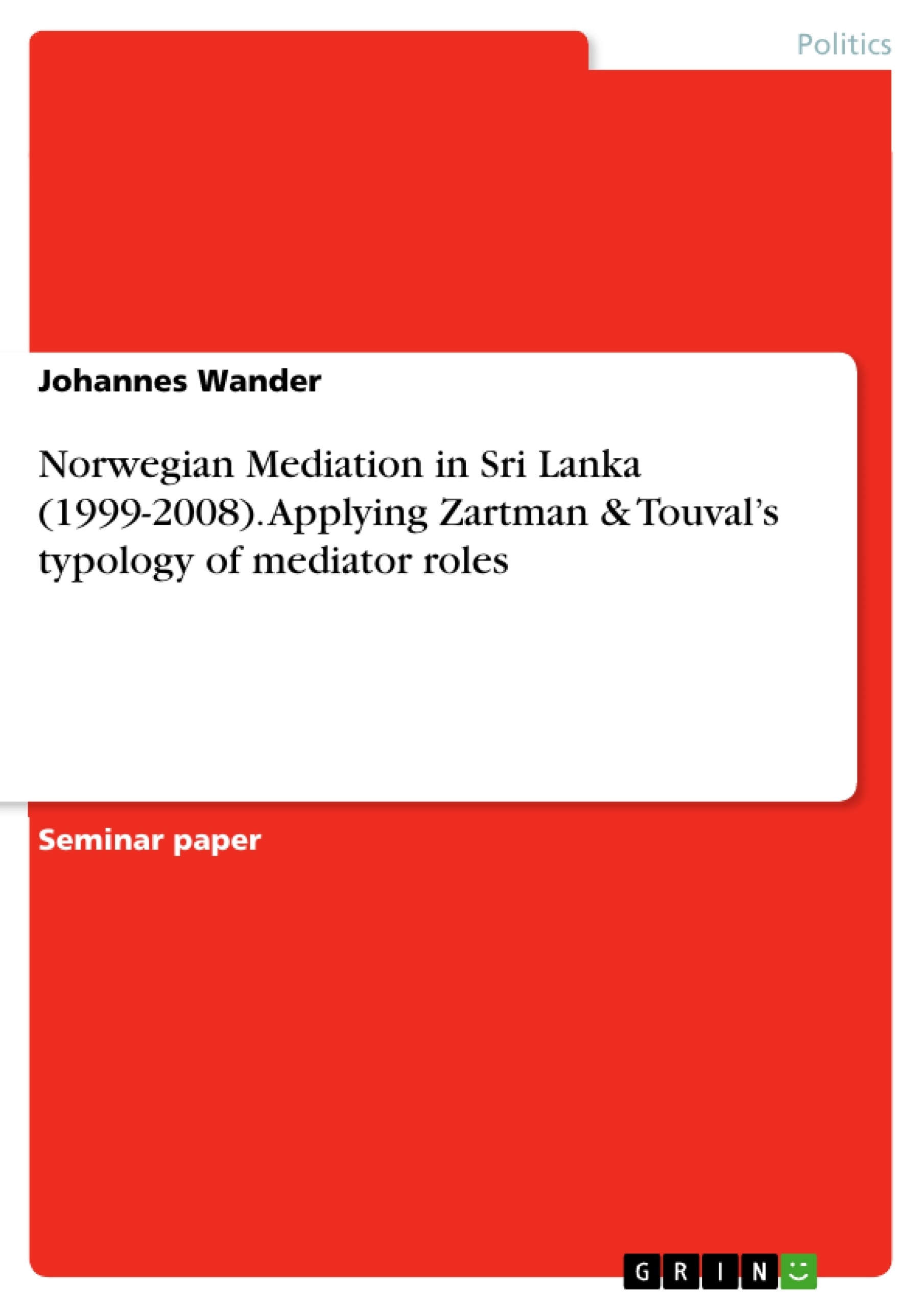This paper aims on applying Zartman & Touval’s (1985) typology of mediator roles on the Norwegian mediation attempt in Sri Lanka between 1999 and 2008. Its purpose is to test if the concept helps understanding the case and the negotiation outcome.
The case of Sri Lanka was selected because it offers various insights for international negotiation scholars due to its long duration and strong intensity, involving different mediators, and various conflict resolution attempts, which mostly failed. I focus on the timeframe between 1999 and 2008 as this reflects the time of the official Norwegian engagement as a mediator in Sri Lanka. In this paper, I will first briefly introduce the concept of mediator roles by Zartman & Touval.
Following, I conceptualize the approach into a research design applied in this paper. The chapter on analysing the case is divided in a mere descriptive part of the Norwegian mediation activities in Sri Lanka and an analytical part where the role of the mediator is identified and discussed. In the final conclusions I will summarize the insights and discuss their relevance for the Sri Lankan case.
Inhaltsverzeichnis (Table of Contents)
- Introduction
- Mediators' Roles Typology
- Methodology
- Analysis
- Norway in Sri Lanka
- Mediator Roles
- Conclusions...
- References
Zielsetzung und Themenschwerpunkte (Objectives and Key Themes)
This paper aims to apply Zartman & Touval's (1985) typology of mediator roles to the Norwegian mediation attempt in Sri Lanka between 1999 and 2008. The paper seeks to determine if this concept helps in understanding the case and the negotiation outcome. The case of Sri Lanka is chosen due to its long duration and intense nature, involving multiple mediators and various conflict resolution attempts, mostly unsuccessful. The paper focuses on the period between 1999 and 2008, reflecting the time of official Norwegian engagement as a mediator in Sri Lanka.
- Applying Zartman & Touval's mediator role typology to the Norwegian mediation in Sri Lanka.
- Analyzing the effectiveness of the mediator roles in achieving successful negotiation outcomes.
- Exploring the different roles of the mediator, including Communicator, Formulator, and Manipulator, in the Sri Lankan context.
- Examining the impact of different mediator roles on the negotiation process and outcome.
- Assessing the strengths and limitations of the mediator role typology in understanding complex international negotiations.
Zusammenfassung der Kapitel (Chapter Summaries)
- Introduction: This chapter introduces the paper's objective, which is to apply Zartman & Touval's mediator role typology to the Norwegian mediation attempt in Sri Lanka. It explains the rationale for choosing this case study, highlighting its significance for international negotiation scholars. The chapter also outlines the paper's structure and methodology.
- Mediators' Roles Typology: This chapter provides an overview of Zartman & Touval's (1985) concept of mediator roles, introducing the three distinct roles: Communicator, Formulator, and Manipulator. It discusses the characteristics of each role and their implications for the mediation process. The chapter also emphasizes the non-mutually exclusive nature of these roles, highlighting the possibility of a mediator adopting multiple roles in a single mediation effort.
- Methodology: This chapter outlines the paper's research question, which focuses on identifying the specific mediator role Norway adopted in Sri Lanka and its impact on the negotiation success or failure. It presents the null hypothesis that Norway applied a Communicator strategy, while the alternative hypotheses suggest Norway adopted either a Formulator or Manipulator strategy. The chapter also details the indicators used to analyze the Norwegian mediation attempt and determine the applied mediator role.
Schlüsselwörter (Keywords)
This paper focuses on the key concepts of international negotiation, mediation, conflict resolution, and mediator roles. It examines the role of Norway as a mediator in the Sri Lankan conflict, utilizing the typology of mediator roles introduced by Zartman & Touval (1985). The paper analyzes the effectiveness of different mediator roles in achieving successful negotiation outcomes and explores the implications of these roles for understanding complex international negotiations. Key terms include: mediator roles, Communicator, Formulator, Manipulator, negotiation, conflict resolution, Sri Lankan conflict, Norwegian mediation.
- Quote paper
- Johannes Wander (Author), 2015, Norwegian Mediation in Sri Lanka (1999-2008). Applying Zartman & Touval’s typology of mediator roles, Munich, GRIN Verlag, https://www.grin.com/document/341496



